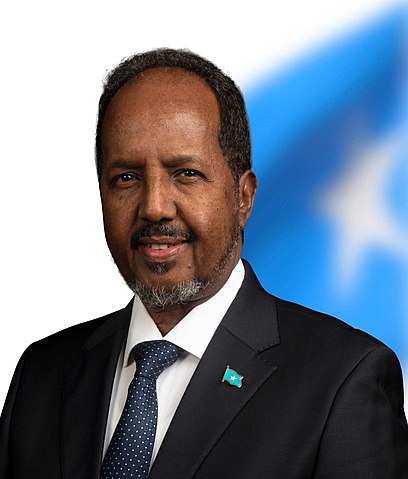|
||||
|
|
||||
|
||||
|
|
||||
 COS, Prez: Hassan Sheikh Mohamud 9.6.2022 > |
 HOG, PM: Hassan BARRE 25.6.2022 > |
|
The first
banknotes attributable to Somalia were issued in 1962. Currency History: ISM currency 1893-1925; ITA 1925-36; IEA 1936-42; EAF 1942-50; ? 1950-62; 1962 > SOM |
||||||||
| - | Page |
Catalog Numbers |
Denominations | Dates | Issuing Authority | |||
|
||||||||
|
|
1 | P.1 - P.4 |
5 - 100 Scellini (Schillings) |
1962 | Banca Nazionale Somala | |||
|
|
5 | P.5 - P.8 |
5 - 100 Scellini (Schillings) |
1966 | Banca Nazionale Somala | |||
|
|
9 | P.9 - P.12 |
5 - 100 Scellini (Schillings) |
1968 | Banca Nazionale Somala | |||
|
||||||||
|
|
13 | P.13 - P.16 |
5 - 100 Scellini (Schillings) |
1971 | Banca Nazionale Somala | |||
|
|
17 | P.17 - P.20 |
5 - 100 Shilin (Schillings) |
1975 | Somali National Bank | |||
|
|
20A | P.20A - P.24 |
5 - 100 Shilin (Schillings) |
1978 | Central Bank of Somalia | |||
|
|
26 | P.26 - P.30 |
10 - 100 Shilin (Schillings) |
1980/81 | Central Bank of Somalia | |||
 |
31 | P.31 - P.35 |
5 - 100 Shilin (Schillings) |
1983/89 | Central Bank of Somalia | |||
 |
36 | P.36 - P.37 |
500 - 1,000 Shilin (Schillings) |
1983/96 | Central Bank of Somalia | |||
|
||||||||
|
||||||||
|
||||||||
| Images Needed | New | P.New | - | - | Central Bank of Somalia | |||
|
||||||||
 |
R1 | P.R1 - P.R2 |
20 - 50 Shilin (Schillings) |
1991 | Central Bank of Somalia | |||
|
||||||||
|
|
R10 | P.R10 |
1,000 Shilin (Schillings) |
1990(2000) | Central Bank of Somalia | |||
|
Britain withdrew from British Somaliland in 1960 in order to allow its protectorate to join with Italian Somaliland and form the new nation of Somalia. In 1969, a coup headed by Mohamed SIAD Barre ushered in an authoritarian socialist rule that managed to impose a degree of stability in the country for a couple of decades. After the regime's overthrow early in 1991, Somalia descended into turmoil, factional fighting, and anarchy. In May of 1991, northern clans declared an independent Republic of Somaliland that now includes the administrative regions of Awdal, Woqooyi Galbeed, Togdheer, Sanaag, and Sool. Although not recognized by any government, this entity has maintained a stable existence, aided by the overwhelming dominance of a ruling clan and economic infrastructure left behind by British, Russian, and American military assistance programs. The regions of Bari, Nugaal, and northern Mudug comprise a neighboring self-declared autonomous state of Puntland, which has been self-governing since 1998, but does not aim at independence; it has also made strides toward reconstructing a legitimate, representative government, but has suffered some civil strife. Puntland disputes its border with Somaliland as it also claims portions of eastern Sool and Sanaag. Beginning in 1993, a two-year UN humanitarian effort (primarily in the south) was able to alleviate famine conditions, but when the UN withdrew in 1995, having suffered significant casualties, order still had not been restored. The mandate of the Transitional National Government (TNG), created in August 2000 in Arta, Djibouti, expired in August 2003. A two-year peace process, led by the Government of Kenya under the auspices of the Intergovernmental Authority on Development (IGAD), concluded in October 2004 with the election of Abdullahi YUSUF Ahmed as Transitional Federal President of Somalia and the formation of a transitional government, known as the Somalia Transitional Federal Institutions (TFIs). The Somalia TFIs include a 275-member parliamentary body, known as the Transitional Federal Assembly (TFA), a transitional Prime Minister, Ali Mohamed GHEDI, and a 90-member cabinet. The TFIs are currently divided between Mogadishu and Jowhar, but discussions to co-locate the TFIs in one city are ongoing. Suspicion of Somali links with global terrorism further complicates the picture. "Somaliland" secessionists provide port facilities to landlocked Ethiopia and establish commercial ties with regional states; "Puntland" and "Somaliland" "governments" seek support from neighboring states in their secessionist aspirations and in conflicts with each other; Ethiopia has only an administrative line with the Oromo region of southern Somalia and maintains alliances with local Somali clans opposed to the unrecognized Somali Interim Government, which plans eventual relocation from Kenya to Mogadishu; rival militia and clan fighting in southern Somalia periodically spills over into Kenya |
![]()